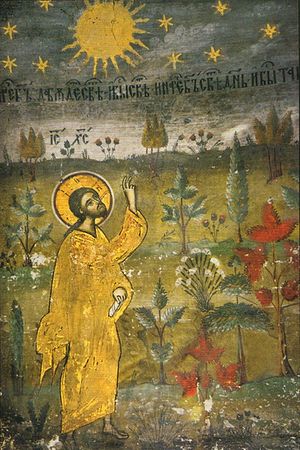Prominent in the writings of Maximus the Confessor is his thought on cosmology--in effect, why God created the cosmos--and eschatology--what will really happen to us and to the non-human physical world at the end of time. Maximus foresees, not only universal bodily resurrection for all humans, but a glorious restoration of the created cosmos in which deified humanity will serve as the channels through which the divine energies will be transmitted to the universe. In this way humanity will serve as "priests of the cosmos".
In this article Jesse Dominick provides an excellent summation of what Maximus has to say on these topics.
++++++++++++++++++++++++++++++++++++++++++++++++++++++++++++++++++++++++
 Conversely, if man is a microcosm, then for St. Maximus the universe is a makranthropos—a man distended, and so the universe can be contemplated as a man. St. Maximus states in his work The Church’s Mystagogy that “the whole world, made up of visible and invisible things, is man and conversely that man made up of body and soul is a world ... intelligible things display the meaning of the soul, as the soul does that of intelligible things, and that sensible things display the place of the body as the body does that of sensible things.”[10] As body and soul constitutes but one man, so the visible and invisible aspects of the universe constitute but one cosmos. As Lars Thunberg explains, this relationship between man and the universe does not remain static, but takes on a dynamic element—“the duality should be transformed into a unity, unthreatened by dissolution. This task of unification is attributed to man as microcosm and mediator.”[11] For St. Maximus, the fact that man is a microcosm suggests and naturally leads to this vocation as mediator, in which man “[recapitulates] in himself the elements of the entire world, in his body and in his soul.”[12] Ambiguum 41, as well as chapters 5 and 7 of The Church’s Mystagogy is relevant for the outlining of this active role of mediating. This role of mediation and unification, of uniting diversity, with all diversity preserved, is a consequence of man’s bearing the image of God, and of man’s personal relationship with God.
Conversely, if man is a microcosm, then for St. Maximus the universe is a makranthropos—a man distended, and so the universe can be contemplated as a man. St. Maximus states in his work The Church’s Mystagogy that “the whole world, made up of visible and invisible things, is man and conversely that man made up of body and soul is a world ... intelligible things display the meaning of the soul, as the soul does that of intelligible things, and that sensible things display the place of the body as the body does that of sensible things.”[10] As body and soul constitutes but one man, so the visible and invisible aspects of the universe constitute but one cosmos. As Lars Thunberg explains, this relationship between man and the universe does not remain static, but takes on a dynamic element—“the duality should be transformed into a unity, unthreatened by dissolution. This task of unification is attributed to man as microcosm and mediator.”[11] For St. Maximus, the fact that man is a microcosm suggests and naturally leads to this vocation as mediator, in which man “[recapitulates] in himself the elements of the entire world, in his body and in his soul.”[12] Ambiguum 41, as well as chapters 5 and 7 of The Church’s Mystagogy is relevant for the outlining of this active role of mediating. This role of mediation and unification, of uniting diversity, with all diversity preserved, is a consequence of man’s bearing the image of God, and of man’s personal relationship with God.
In this article Jesse Dominick provides an excellent summation of what Maximus has to say on these topics.
++++++++++++++++++++++++++++++++++++++++++++++++++++++++++++++++++++++++
With the unity of man in both composition and purpose firmly established, we can begin to look at man’s central position in St. Maximus’ cosmology, in which the fate of the entire cosmos is tied to that of man. As Torstein Theodor Tollefsen writes in his The Christocentric Cosmology of St. Maximus the Confessor: “[man] is created just for this purpose: to actualize the created potential of his being to achieve a fully realized community between all creatures and their Creator.”[9] In his vision of this task, man is described by St. Maximus as a microcosm (ό μικρὸς κόσμος) because man is composed of both body and soul—both physical and spiritual, sensible and intelligible natures, he is thus the creation in miniature, as creation also consists of both physical and spiritual realities. In this he is following upon the Cappadocian Fathers, and Nemesius of Edessa. Man occupies a “middle” position in creation, straddling the division between the material world that we inhabit and the spiritual world of the angelic powers.

This entry was posted
on Sunday, August 26, 2018
at Sunday, August 26, 2018
. You can follow any responses to this entry through the
comments feed
.






